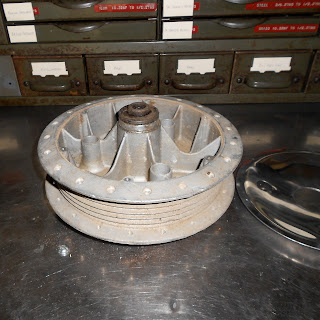Norton Brakes & Hubs
This will be sort of an ongoing chronicle of parts and projects that are literally "on the bench", and getting their turn at repair / rebuilding / restoration.
All of these parts are standard Norton bits and would be found on any Dominator or Atlas from the mid 1950's through the later part of the 1960's. The rear hub was purchased inexpensively at the Road America swap meet, while all other parts were purchased as a lot from a gentleman in Kansas. As is with most of these things, they've just been discarded over the years and have sat dormant, collecting dirt, grease and rust. Until now that is.
These particular pieces don't have any immediate use on my Atlas or Dominator project, so for now they'll be considered spares, or potentially for sale at a later date. I don't sell junk, so when / if any of these parts come up for sale, they'll be completely restored.
First up is a standard Norton single leading shoe brake plate. This was first up to be disassembled and the initial cleaning started. I sort of jumped the gun and had started before shooting these photos, so you'll see that it's already been taken apart, dusted off, and the brake plate got a quick polish on the wheel so that I could see how deep the gouges were in the aluminum.
On to the rear hub and brakes. One is just a brake plate, complete with shoes and brake arm. The other is a complete drum with sprocket, brake plate and shoes. The complete unit looked terrible and took a few minutes to remove it from the drum. Inside was enough rust to warrant this needing some serious attention. These photos were taken after I had already cleaned them with the brass wire brush. As can be seen, they'll need further cleaning.
The brake drum is cast iron, so the rust tends to accumulate and look much worse than it probably is. But it'll need to resurfaced before it sees any use.
All of the cast iron and steel parts will be sand blasted with a soft media that's normally used to blast aluminum.
Anything aluminum will either just be cleaned with solvent and a brass wire brush, or potentially a soda blast. I never media blast cast aluminum as it ruins the original factory finish, and just as a personal preference, I always aim to maintain that finish.
After that, the outer drum surface, rear brake plates and brake arm will be painted back to their original black finish. The front brake plate will be lighted sanded to remove any deep gauges and then polished. It'll likely need a new bushing as well. The shoes will be cleaned, new pads fitted and then turned down to fit the drum. All the hardware will be cleaned and retained unless it's beyond use. Generally speaking, the hardware tends to clean up nicely and can simply be reused. In some cases, they'll need to be sent out with the next batch of fasteners that gets plated.
The front brake lever is chromed steel and badly pitted. Most likely even if it were to be stripped and re-chromed, it wouldn't look very nice. But we'll give it a shot and see. I had plans to fabricate my own aluminum lever with some period speed holes drilled into it. I've also got plans for a period alloy scoop to be added to the front brake plate and some cooling holes drilled into it. But that project goes along with another very special hub that's on its way. More about that later.
Lastly, a standard Norton bolt up rear hub. This one is pretty straight forward and cleaned up nicely just with the brass wire brush. It'll need another round of that, but should clean up nicely. The hub cap cover was in tact as were the original screws. The hub cap has been sanded and one spot polished just for inspection purposes. Obviously the whole unit will be treated to new bearings.
It'll be a while before any of these parts are finished. Since they're simply for spares, I'll work on them as time permits. Anything that's needed for the Dominator project will take priority. But I'll report back as these things get finished up.
I often wonder why these parts were discarded in the first place. They always need a good inspection to see if they were set aside due to damage, and therefore are either unusable or in need of serious repair. I like to think that previous owners removed these from bikes in order to fit more exotic parts, but I doubt that to be the case. Either way, all of these parts look to be in fine shape, so once they're restored, they'll be usable on any of my machines.
In the end, I'll surely have more money and way more time into these parts than they're technically worth. Most people wouldn't care about any of these things, and certainly wouldn't want to buy them for the amount of money that would be into them. But to me, they're worth saving, and should have there day being called back into service.










No comments:
Post a Comment